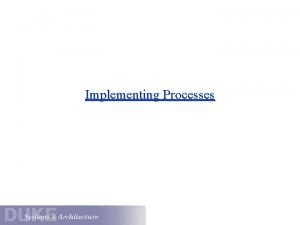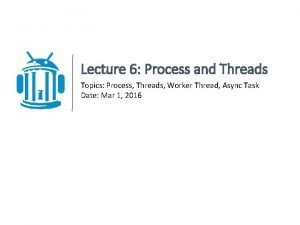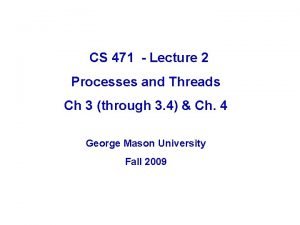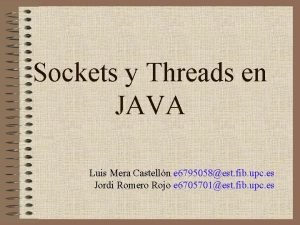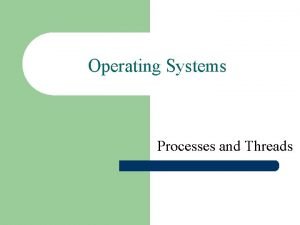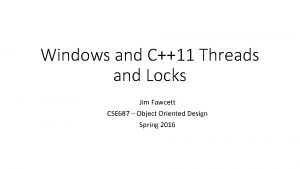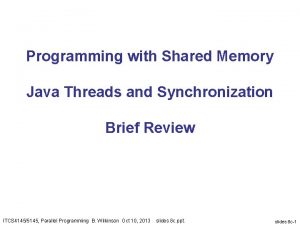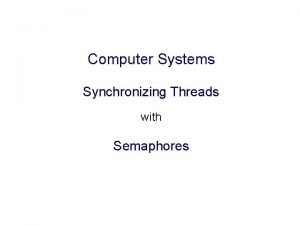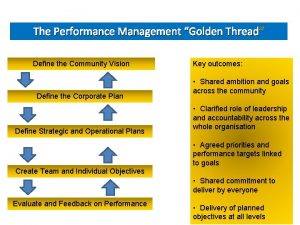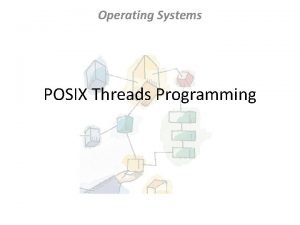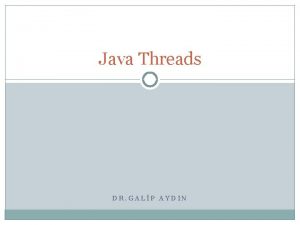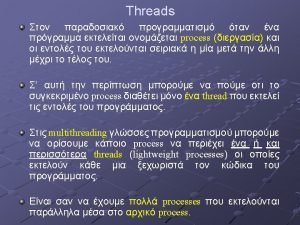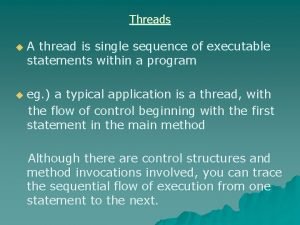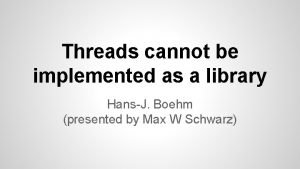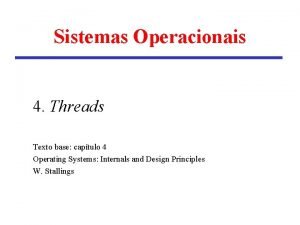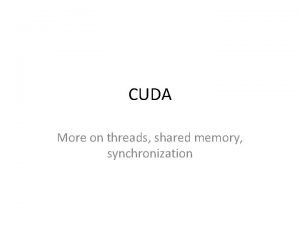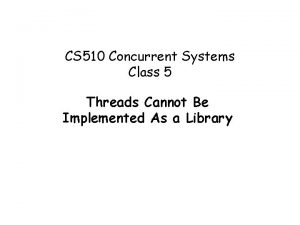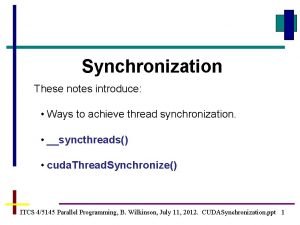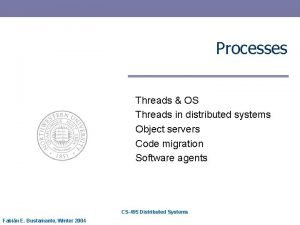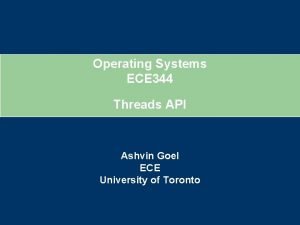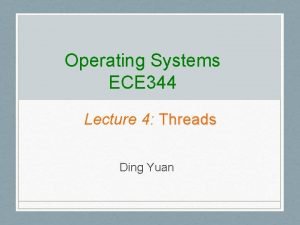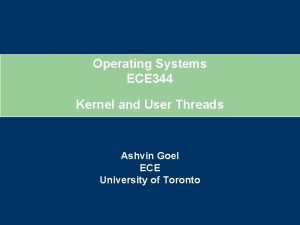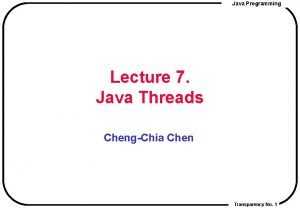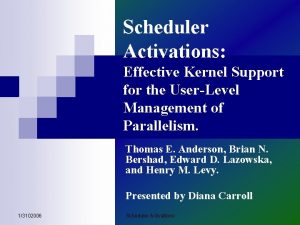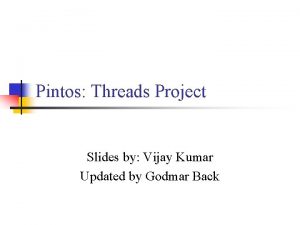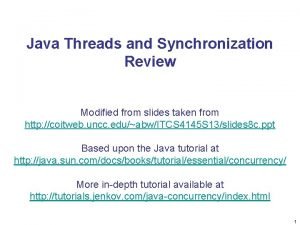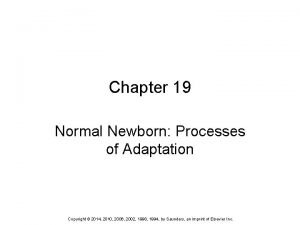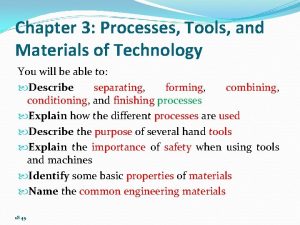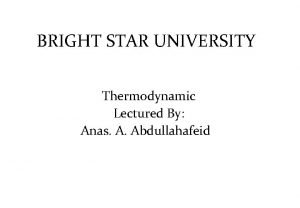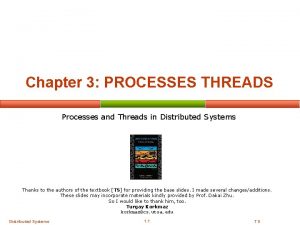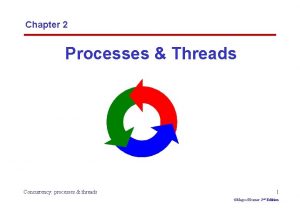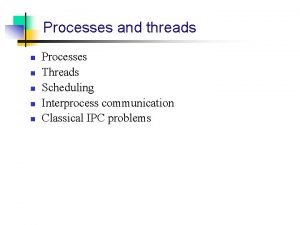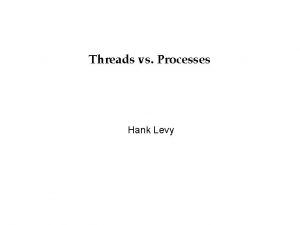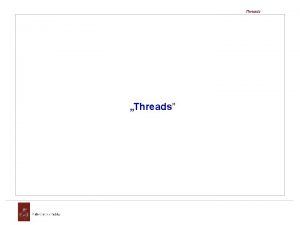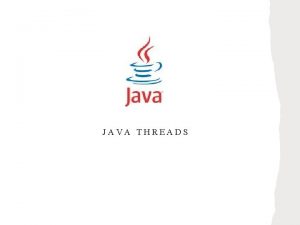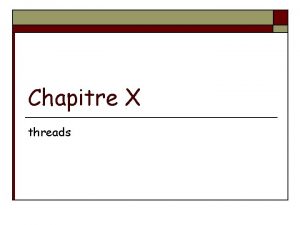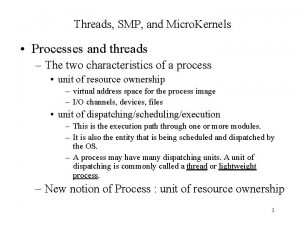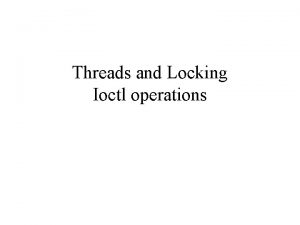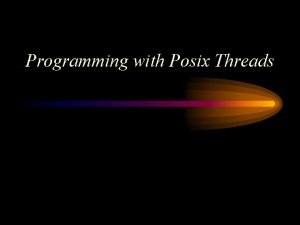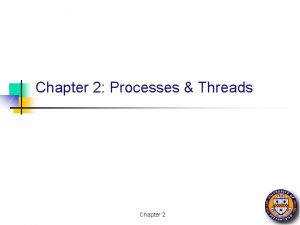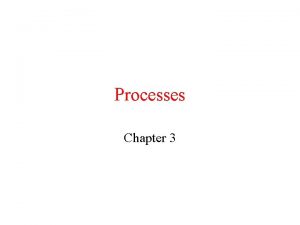Chapter 2 Processes and Threads 2 1 Processes























































- Slides: 55

Chapter 2 Processes and Threads 2. 1 Processes 2. 2 Threads 2. 3 Interprocess communication 2. 4 Classical IPC problems 2. 5 Scheduling 1

Processes The Process Model • Multiprogramming of four programs • Conceptual model of 4 independent, sequential processes • Only one program active at any instant 2

Process Creation Principal events that cause process creation • System initialization • Execution of a process creation system • User request to create a new process • Initiation of a batch job 3

Process Termination Conditions which terminate processes • Normal exit (voluntary) • Error exit (voluntary) • Fatal error (involuntary) • Killed by another process (involuntary) 4

Process Hierarchies • Parent creates a child process, child processes can create its own process • Forms a hierarchy – UNIX calls this a "process group" • Windows has no concept of process hierarchy – all processes are created equal 5

Process States (1) • Possible process states – running – blocked – ready • Transitions between states shown 6

Process States (2) • Lowest layer of process-structured OS – handles interrupts, scheduling • Above that layer are sequential processes 7

Implementation of Processes (1) Fields of a process table entry 8

Implementation of Processes (2) Skeleton of what lowest level of OS does when an interrupt occurs 9

Threads The Thread Model (1) (a) Three processes each with one thread (b) One process with three threads 10

The Thread Model (2) • Items shared by all threads in a process • Items private to each thread 11

The Thread Model (3) Each thread has its own stack 12

Thread Usage (1) A word processor with three threads 13

Thread Usage (2) A multithreaded Web server 14

Thread Usage (3) • Rough outline of code for previous slide (a) Dispatcher thread (b) Worker thread 15

Thread Usage (4) Three ways to construct a server 16

Implementing Threads in User Space A user-level threads package 17

Implementing Threads in the Kernel A threads package managed by the kernel 18

Hybrid Implementations Multiplexing user-level threads onto kernellevel threads 19

Scheduler Activations • Goal – mimic functionality of kernel threads – gain performance of user space threads • Avoids unnecessary user/kernel transitions • Kernel assigns virtual processors to each process – lets runtime system allocate threads to processors • Problem: Fundamental reliance on kernel (lower layer) calling procedures in user space (higher layer) 20

Pop-Up Threads • Creation of a new thread when message arrives (a) before message arrives (b) after message arrives 21

Making Single-Threaded Code Multithreaded (1) Conflicts between threads over the use of a global variable 22

Making Single-Threaded Code Multithreaded (2) Threads can have private global variables 23

Interprocess Communication Race Conditions Two processes want to access shared memory at same time 24

Critical Regions (1) Four conditions to provide mutual exclusion 1. 2. 3. 4. No two processes simultaneously in critical region No assumptions made about speeds or numbers of CPUs No process running outside its critical region may block another process No process must wait forever to enter its critical region 25

Critical Regions (2) Mutual exclusion using critical regions 26

Mutual Exclusion with Busy Waiting (1) Proposed solution to critical region problem (a) Process 0. (b) Process 1. 27

Mutual Exclusion with Busy Waiting (2) Peterson's solution for achieving mutual exclusion 28

Mutual Exclusion with Busy Waiting (3) Entering and leaving a critical region using the TSL instruction 29

Sleep and Wakeup Producer-consumer problem with fatal race condition 30

Semaphores The producer-consumer problem using semaphores 31

Mutexes Implementation of mutex_lock and mutex_unlock 32

Monitors (1) Example of a monitor 33

Monitors (2) • Outline of producer-consumer problem with monitors – only one monitor procedure active at one time – buffer has N slots 34

Monitors (3) Solution to producer-consumer problem in Java (part 1) 35

Monitors (4) Solution to producer-consumer problem in Java (part 2) 36

Message Passing The producer-consumer problem with N messages 37

Barriers • Use of a barrier – processes approaching a barrier – all processes but one blocked at barrier – last process arrives, all are let through 38

Dining Philosophers (1) • • Philosophers eat/think Eating needs 2 forks Pick one fork at a time How to prevent deadlock 39

Dining Philosophers (2) A nonsolution to the dining philosophers problem 40

Dining Philosophers (3) Solution to dining philosophers problem (part 1) 41

Dining Philosophers (4) Solution to dining philosophers problem (part 2) 42

The Readers and Writers Problem A solution to the readers and writers problem 43

The Sleeping Barber Problem (1) 44

The Sleeping Barber Problem (2) Solution to sleeping barber problem. 45

Scheduling Introduction to Scheduling (1) • Bursts of CPU usage alternate with periods of I/O wait – a CPU-bound process – an I/O bound process 46

Introduction to Scheduling (2) Scheduling Algorithm Goals 47

Scheduling in Batch Systems (1) An example of shortest job first scheduling 48

Scheduling in Batch Systems (2) Three level scheduling 49

Scheduling in Interactive Systems (1) • Round Robin Scheduling – list of runnable processes after B uses up its quantum 50

Scheduling in Interactive Systems (2) A scheduling algorithm with four priority classes 51

Scheduling in Real-Time Systems Schedulable real-time system • Given – m periodic events – event i occurs within period Pi and requires Ci seconds • Then the load can only be handled if 52

Policy versus Mechanism • Separate what is allowed to be done with how it is done – a process knows which of its children threads are important and need priority • Scheduling algorithm parameterized – mechanism in the kernel • Parameters filled in by user processes – policy set by user process 53

Thread Scheduling (1) Possible scheduling of user-level threads • 50 -msec process quantum • threads run 5 msec/CPU burst 54

Thread Scheduling (2) Possible scheduling of kernel-level threads • 50 -msec process quantum • threads run 5 msec/CPU burst 55
 Process vs thread
Process vs thread Threads vs processes
Threads vs processes Concurrent in os
Concurrent in os Process and threads
Process and threads Process and threads
Process and threads Sockets and threads
Sockets and threads Process and threads in operating system
Process and threads in operating system C11 thread
C11 thread Shared memory in java
Shared memory in java Conventional representation of external screw thread
Conventional representation of external screw thread Flexible flat material made by interlacing yarns
Flexible flat material made by interlacing yarns Tipos de escalonamento
Tipos de escalonamento Os threads
Os threads The vinaya pitaka is a sacred text of………….
The vinaya pitaka is a sacred text of…………. Needle like threads of spongy bone
Needle like threads of spongy bone Square of chalk makes temporary marks on fabric
Square of chalk makes temporary marks on fabric Golden thread process
Golden thread process Pintos priority donation
Pintos priority donation Pthreads
Pthreads Threads java
Threads java Osteospermum white lightning
Osteospermum white lightning Forum.unity.com/threads/game-over.54735
Forum.unity.com/threads/game-over.54735 /threads/ fiji
/threads/ fiji Threads consumes cpu in best possible manner
Threads consumes cpu in best possible manner Lightweight thread
Lightweight thread Forum.unity.com/threads/game-over.54735
Forum.unity.com/threads/game-over.54735 Sequence diagram threads
Sequence diagram threads Threads cannot be implemented as a library
Threads cannot be implemented as a library Threads.h
Threads.h Eccentric turning on lathe machine
Eccentric turning on lathe machine Cuda threads per block
Cuda threads per block Threads cannot be implemented as a library
Threads cannot be implemented as a library Two level model thread
Two level model thread Cuda synchronize threads
Cuda synchronize threads Threads in distributed systems
Threads in distributed systems Qscheduler
Qscheduler Ece threads
Ece threads Ece threads
Ece threads Chia 3 threads
Chia 3 threads Scheduler activations
Scheduler activations Pintos threads
Pintos threads Mission thread example
Mission thread example Threads em java
Threads em java Os threads
Os threads Types of jaycustomers
Types of jaycustomers Chapter 19 normal newborn processes of adaptation
Chapter 19 normal newborn processes of adaptation Study of behavior and mental processes
Study of behavior and mental processes Decision processes wharton
Decision processes wharton A system has 12 magnetic tape drives and 3 processes
A system has 12 magnetic tape drives and 3 processes Dynamics of a community
Dynamics of a community It is used to process materials by hand
It is used to process materials by hand Reversible and irreversible processes in thermodynamics
Reversible and irreversible processes in thermodynamics Hsc multiple choice generator
Hsc multiple choice generator Marzano element 19
Marzano element 19 Why designing and managing service processes
Why designing and managing service processes Word formation processes
Word formation processes

